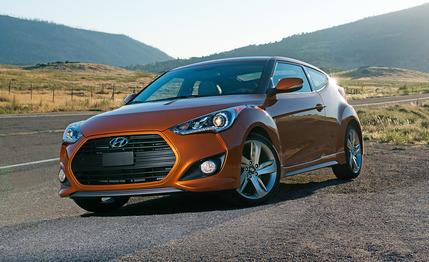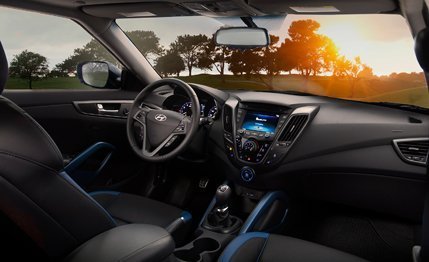
 First Drive Review
First Drive Review
Restraint is a noble thing, and Hyundai sets an excellent example with the 2013 Veloster Turbo. The 201-hp version of this half-coupe/half-sedan/half-hatchback is everything it could be without becoming things it shouldn’t be, including expensive.
As we’ve previously reported, the Veloster is an odd little bulldog cadged together from platform pieces of the Accent and Elantra. The two-plus-one asymmetrical side doors are as novel as they are practical, but much about the Veloster’s blueprint is engineering code for “economy car.” There are struts in front and a twist-beam axle in back. The Veloster is also no stiffy. At 2800 or so pounds, the car has large holes cut into its body for three doors, a hatch, and the giant optional sunroof, which adds weight and does nothing for structural integrity. Thus, the steering column and the floor often echo with road vibrations, as they might do in a convertible.
The electric power steering is adequate if generally lifeless, and the base car’s 138-hp, 1.6-liter four with a six-speed manual delivers 60 mph in 8.5 seconds. That’s thrilling only if your other car is a UPS truck.
So here comes the Turbo, which, at $22,725 to start, makes for a relatively cheap date to the 200-horse ball. Hyundai figures that with all the Turbo’s standard content you’re paying just a $1600 premium for the turbo engine. It’s essentially the same direct-injection, cast-aluminum 1.6-liter but with an intercooled twin-scroll turbo and a 9.5:1 compression ratio. Hyundai claims 201 hp on the roof (6000 rpm) and 195 lb-ft of torque in the basement (1750 rpm), all on regular fuel. The EPA numbers with the manual will be 26 mpg city and 38 highway.


With another 63 horses and 72 lb-ft churning the butter, the Veloster Turbo feels like its load has been lifted. The torque band opens up, and the acceleration is stronger and more accessible across a wider range, but unlike the gloriously blatty Fiat Abarth 500, it continues to sound worker-bee dull. Incidentally, Hyundai says the Turbo makes too much twist for the base Veloster’s dual-clutch automatic, so the Accent’s conventional six-speed auto with steering-wheel paddles sits next to the six-speed manual on the Turbo’s order sheet.
What the folks at Hyundai did not do—and we applaud them for it—is crank down the suspension. Little about the base Veloster’s chassis changes beyond larger front-brake discs (11.8 inches instead of 11.0) and bigger, 18-inch wheels with 215/40 Kumho Solus tires. They’re not even summer tires, just all-seasons, and no factory upgrade is offered.
What about this is laudable? Well, car companies typically tamper with the suspensions of their turbo über-sports versions to make them sway less and thereby impress car magazines on luxury junkets to the Alps. But back home on America’s mean streets, this often makes the axles feel welded to the body and the ride unbearable. In the Veloster, it would have only accentuated the structure’s weaknesses.